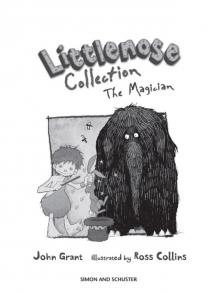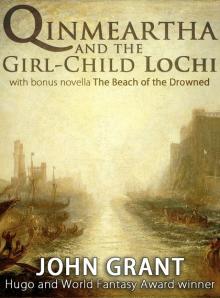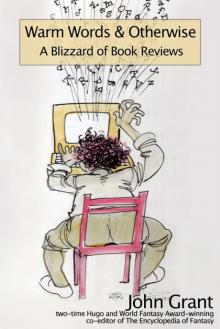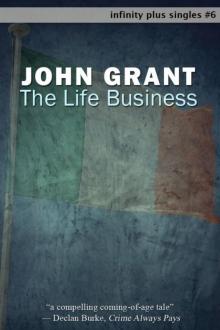- Home
- John Grant
Warm Words & Otherwise: A Blizzard of Book Reviews Page 6
Warm Words & Otherwise: A Blizzard of Book Reviews Read online
Page 6
I could hardly recommend that you rush out and buy Sarah's Landing 1, but the possibility remains that Bowman may, one day, either find a good editor or learn to edit herself – and preferably both. In that event, she may be one to watch.
—Infinity Plus
Pretty Dead
by Gerry Boyle
Berkley Prime Crime, 336 pages, hardback, 2003
Jack McMorrow is the Maine stringer for the New York Times, having deliberately moved himself away from the pressures of cutting-edge journalism. However, his semi-retirement from the fray hasn't isolated him from high-profile crime cases; this is the latest addition to Gerry Boyle's series about him and his permanent other, Roxanne Masterson, a social worker.
It's through Roxanne that Jack is brought into this latest case. The daughter of powerful, wealthy (think Kennedys) David and Maddie Connelly has been reported as suffering bruises that might indicate child abuse, and Jack tags along when Roxanne goes to interview the family. They get drawn into the Connellys' social circle, meeting various of the staff of the Connellys' own foundation. A few days later, Jack goes to a crime scene and finds that the victim is Angel Moretti, a sexbomb temptress and, seemingly, manipulating cocktease whom he met during a Connelly gathering. As he tries, with Roxanne's assistance, to track down the killer he is both threatened by hoodlums and cooperated with by the Connellys.
But are the Connellys all that they seem? Are they genuinely cooperating? For all that they blame a sacked and now conveniently disappeared nanny, could it be that they were indeed responsible for those bruises? Is it possible for Jack to do his job as a reporter while at the same time doing his job as (now) a friend to make sure the Connellys are subjected to as little unjustified public attention as possible? Is there a Mob involvement? And why is Maddie Connelly – the woman who seems to have everything – seemingly so scared of her own shadow?
There are plenty of questions to be asked, and Jack sets about finding the answers – aware all the time that the killer may be closer to Roxanne and himself than he thinks.
The combination of mystery and thriller is not always easy to achieve – ratiocination and action thrills offer two different forms of excitement – but Boyle makes a very good fist of it in this novel; the final fifty pages or so are as compulsive as anything you'll find in any edge-of-your-chair thriller. There's one major "cheat" in the ratiocination aspect of the tale: I can't detail it for fear of giving away too much, but essentially Jack is seriously misinformed about something for no apparent purpose other than to mislead the reader. Aside from that, this is a good detective novel as well as well as an effective thriller.
The characterization is nicely done as well; for the most part one gets the impression one has come to know these people. (The portrayal of the victim is especially vivid.) The writing's nice without being prissy, and there are some good one-liners. Yet my enthusiasm was tempered, partly because of the "cheat" mentioned above and partly because what the novel doesn't quite succeed in capturing is atmosphere. The two principal settings are rural Maine and Boston, and certainly this reader didn't get the feel of either. That, of course, doesn't matter too much if everything else is working well; but it does render Pretty Dead less lingering than it might have been.
—Crescent Blues
From the Dust Returned
by Ray Bradbury
Morrow, 204 pages, hardback, 2001
This book has an extremely interesting Afterword about its genesis. It began with the publication, in the October 1946 issue of Mademoiselle, of Bradbury's famous story "Homecoming", which had earlier been rejected outright by Weird Tales, the pulp to which Bradbury had been a somewhat uneasy but regular contributor for several years. The story's appearance in Mademoiselle was illustrated – with a full double-page spread, no less – by Charles Addams, and the two men soon after decided that, over the next few years, they would create a book together: Bradbury would write further stories concerning the Family, the assemblage of supernatural quasi-humans introduced in "Homecoming", and Addams would illustrate them. Other commitments got in the way of good intentions, and the proposed book never came to fruition ... until now, long after Addams's death. All that survives of Addams's intended contribution is the book's cover illustration, which is that old double-page spread from Mademoiselle.
This book is billed as a novel. It isn't. And neither is it really a collection of short stories. Rather, it is a book of prose that contains six previously published short stories, three new ones, and a goodly number of short (often extremely short and inconsequential) interpolated prose passages that sometimes verge on short-storyhood but are mainly just included for the sake of atmospherics. The book itself is short: many of those 204 smallish pages are blank, and the leading of the type is very generous. On occasion the jury-rigging together of its components becomes over-evident, as at the start of the story "West of October", well into the book (page 69): here we find half a page telling us all sorts of stuff about the Family that we already know, but it's been left in there because it was, necessarily, in the original publication of the story.
The book is also billed as "A landmark event more than fifty years in the making – and a new occasion for rejoicing". I'm not too sure it's that, either.
Somewhere at the top of a hill, somewhere in probably the Midwest, somewhen in probably the middle of the 20th century or thereabouts, there stands a House whose occupants are members of a Family whose other members are scattered all over the globe. Some of the Family seem vampirish, but to describe them as vampires would be to oversimplify: instead they are the dead who are not dead, or some such.
The principal family members with whom we are concerned are A Thousand Times Great Grandmère, who is the mummified mother of Nefertiti; Cecy, who forever sleeps in the attic but whose thoughts can wander far and wide and possess the bodies of others; the bat-winged Uncle Einar, who is a joyously playful friend to children; and Timothy, a mortal foundling, now a ten-year-old and the Family's determined historian (and presumably a surrogate character for Bradbury himself, upon whose own childhood the scenario is – extremely loosely! – based). Also somewhat near centre stage are Father and Mother (that is, Timothy's adoptive father and mother), who are strange in themselves but never really coalesce in the mind's eye.
The previously published stories are "The Traveler" (Weird Tales, 1945), in which the Family must cope with the arrival of rogue relative John the Unjust, a Vlad Drakul figure who might destroy their integrity; "Homecoming", in which, during a gathering at the House of all the far-flung Family, Timothy learns to accept and revel in his mortality; "Uncle Einar" (Dark Carnival, 1947), in which the eponymous character loses his battish sonar and thus can no longer fly at night, and so must find a way of flying by day without being recognized as a "monster" and shot down by humans; "The Wandering Witch" (Saturday Evening Post, 1952, as "The April Witch"), in which Cecy, a-quest for the experience of love, enters the body of a young woman and forces her to be polite, for just one evening, to a young man whom she dislikes; "On the Orient North" (The Toynbee Convector, 1988), a slightly twee but nevertheless effective ghost story spoiled by a predictable ending and somewhat bolted onto the rest of such structure as there is; and "West of October" (The Toynbee Convector, 1988), in which the excorporated spirits of four young men are drafted into the mind of A Thousand Times Great Grandmère's spouse, where they discover a world of romance and sex that they decline to leave.
Most of these are good stories, but the first four are extremely familiar from widespread publication in other books while the latter two will be well known to Bradbury devotees.
What then of the three new stories? In "Make Haste to Live" a buried Family member is disinterred and over succeeding weeks become rapidly younger until she vanishes in a sexual encounter. In "Return to the Dust", not quite a free-standing story, the attention of mortals has been drawn to the House, thanks to the malevolence of John the Unjust (op cit.), and so the Family must flee their se
parate ways. Finally, "The Gift", again not quite a free-standing story, sees Timothy present A Thousand Times Great Grandmère to an Egyptian museum of antiquities.
So much for characters and content. As it's not really profitable to discuss the plot of a non-novel, what about the writing style?
Bradbury has never made any secret of the fact that the major stylistic influence on his writing is that of Thomas Wolfe. (A note for the youthful: This is the Thomas Wolfe of You Can't Go Home Again, not the Tom Wolfe of Bonfire of the Vanities.) If anything, Bradbury for a couple of decades wrote Thomas Wolfe better than Thomas Wolfe did: ignoring the subject matter, the stories in, say, The Martian Chronicles/The Silver Locusts (1950) – another non-novel, but oh what a magnificent one – had all Wolfe's richness of imagery and language but also a greater stylistic discipline. Where Wolfe was always in danger of lurching into purpleness, Bradbury, with less rambling sentences and particularly with shorter paragraphs, always kept just this side of the narrow dividing line between floweriness and flaccidity. All through the 1940s and 1950s he maintained his grip on this precarious position with astonishing skill.
Around the time of his story collection The Machineries of Joy (1964), however, the grip seemed to be starting to slip. It was as if Bradbury had, well, run out of things to say and stories to tell, and was trying to compensate for this lack by an ever-increasing linguistic grandiosity that often veered into something approaching self-parody, as if Gerard Manley Hopkins had become possessed by the spirit of William McGonagall and the two personalities were fighting it out. It is no coincidence that I cite the names of two poets here, because Bradbury's great strength as a stylist hitherto had been the robust poetic zeal of his language; now too many of the metaphors were misfiring, and what had once been a rich swirl was becoming too often a gush.
His subject matter was changing, too: many and then most of the stories were well clear of the realms of fantasy. Of course, there's no objection at all – certainly from this quarter – to such a switch of focus; but the loss of the fantastic from Bradbury's writing did make even more obvious the flagging of his style. I can remember reading, in the early 1970s, a Bradbury collection and a collection by the Irish writer Frank O'Connor. The subject matter of the two sets of stories was not at all dissimilar, and I sadly had to admit that O'Connor's beautifully taut yet richly written fictions made Bradbury's read like a self-indulgent and amateurish attempt at emulation. (For all I know Bradbury has never even heard of O'Connor, of course; but that's the way the stories read.) Yes, O'Connor's language was fully as poetic as Bradbury's; yet it did not obviate his tales possessing a powerful narrative drive.
And it seems to me that Bradbury has never recaptured the joyous exuberance, both stylistic and narrative, of his early fictions – which were tales that any writer would have been proud to have written. From the Dust Returned would seem to be just a further evidence in favour of my contention. By contrast with the early tales, there are countless examples here among the new material of flaccid, self-indulgent overwriting, some of which are near comic:
• ... sucking vile liquors toward a surface abandoned because of the possible upchuck of nightmares ...
• Planes fly like pterodactyls on huge wings.
Oh yes? So the planes are flapping their flexible wings up and down in a complexly articulated fashion?
• ... you looked down to see your pale light painting lost towns the color of tombstones and spectral ghosts.
As opposed to the non-spectral type of ghosts.
• She leaned forward suddenly and gave him such a kiss on his mouth that his eardrums fractured and the soft spot
• With one last crushing gesture he crammed his fist to his ears and dropped dead.
• A rabbit thumped and ran in Timothy's chest.
• "Like ghosts?" // "Which use people's ears to look out their eyes!"
Actually, I suppose if you've managed to cram a single fist in both ears simultaneously this last one shouldn't be too difficult as an encore.
Let it not be thought that there are no nuggets of gold to be found in From the Dust Returned. Some of the reprinted stories have, for obvious reasons, all the exquisite fantastication of language and imagery that led in the first place to Bradbury's eminence; and elsewhere, in the more recent work, every now and then it is as if the same Muse had called back briefly to blow a breath of inspiration into his face. When this happens, the prose and imagery suddenly lift exhilaratingly off the ground, and one is left gasping. But then, all too soon, we're back to rabbits thumping and running in Timothy's chest. The overall impression with which I came away from this book was thus, sadly, that it's a very slight piece of work ... and that it's about time I dug out that dusty copy of Bradbury's splendid non-novel Dandelion Wine (1957) to read it yet again.
—Infinity Plus
Let's All Kill Constance
by Ray Bradbury
Morrow, 210 pages, hardback, 2003
The nameless narrator of this book, a Hollywood screenwriter – clearly identified by the circumstantial information given on page 68 as Bradbury himself – is beachfront neighbour to fading movie queen Constance. One dark and stormy night she comes to him telling him that she is in threat of her life; when she shortly afterwards disappears he goes off on a quest – sometimes on his own, sometimes accompanied by one or more friends including cynic-with-heart-of-gold private eye Crumley – in an attempt initially to save her but soon just to work out what the hell is going on. As we follow them we gain a portrait of the Hollywood of yesteryear, its idiosyncrasies and its fundamental glamorous tawdriness.
This is Bradbury's third attempt at a roman-a-clef noir detection – earlier were Death is a Lonely Business (1985) and A Graveyard for Lunatics (1990) – and it's enjoyable enough in a superficial sort of a way: vaguely entertaining, but completely uninvolving. It is this latter quality, or lack thereof, which is the novel's downfall as a noir, for noirs depend above all on an atmosphere that requires the total involvement of the reader. Bradbury's natural style, with its flightiness and exaggerated poeticism, works against him in this genre – ironic to find oneself saying this, because of course it was precisely that style which made particularly his early works of fantasy so comprehensively engrossing. There it was perhaps that the style left open so much space for ambiguity; here the ambiguity irks. (Chandler's language, for example, was often richly poetic, but at the same time its meaning was always crystal clear.) Here's a sample:
All the doors still stood wide, bright lights burned inside while Gershwin punched holes in a player piano roll in 1928 to be played again and again, triple time, with no one listening except me and Crumley walking through lots of music, but no Constance.
Even after one's worked out the meaning of this sentence there are still, as it were, bits of scattershot phrasing left flying adrift. That "triple time", for example. Did Gershwin, working in 1928, record the pianola roll at one-third speed? Perhaps pianola rolls were always recorded at one-third speed, for technological reasons – the punches could work only so fast, or something? If so, this is a bit of knowledge beyond your humble reviewer's ken. Or maybe Constance set her pianola to play at three times normal speed. Come to think of it, it must have been an electric pianola, because otherwise she'd still be sitting there pumping the pedals. When was the electric pianola invented? And so on.
A reasonable practitioner of noir fiction would have had the mesmerized reader two-thirds of the way through the chapter after next by now, not still stuck on page 20 grappling with this sentence.
There are some memorable moments, though, most notably the narrator's encounter with Constance's first, forgotten-nonentity husband, now dwelling eremitically in a hilltop shack surrounded by tottering megaliths of piled old and rotting newspapers. There is a skewed richness in such caricatural scenes, reminiscent of Mervyn Peake. But they are oases of vividness amid much that is desert.
There are annoying technical blemishes. On pages 44-5 there's
an extended exchange of dialogue in the midst of which Bradbury loses track of which of the two characters is speaking. On page 72 there's reference to the British beer Old Peculier, but spelt "Old Peculiar". And so on.
But what's most irritating of all about this book is its lack of ambition. Yes, even the greatest of writers – and Bradbury's career speaks for itself – may obviously want to relax with a romp every now and then rather than attempting a masterpiece with each and every new book, but Bradbury of all people is surely capable of producing an excellent romp rather than just a piece of lazy froth like this.
To put this another way: Bradbury has the prized capacity to create works that (and this is irrespective of whether the reader necessarily likes all of them) give the impression of having been greatly loved – loved with an enormous passion, with a fullness of the heart – by the writer. It's a magical ability, and every writer in the world wishes s/he had it.
This book doesn't have that quality.
—Infinity Plus
Boost
by Steve Brewer
Speck Press, 252 pages, hardback, 2004
Sam Hill is a professional car thief. Boosting cars is his main source of emotional stimulus ... with the possible exception of his romantic yearnings toward his fence, Robin Mitchell, daughter of the fence and car thief who mentored Sam way back in the days before he'd found anything worthwhile to do with his life. In turn Sam is mentoring the youth Billy Suggs, teaching him not just how to be a car thief but the artistry of the profession – for Sam's specialty is not common-or-garden theft but the stealing, under commissions channeled through Robin, of rare and collectible items.

 Littlenose Collection The Magician
Littlenose Collection The Magician Qinmeartha and the Girl-Child LoChi
Qinmeartha and the Girl-Child LoChi Take No Prisoners
Take No Prisoners Warm Words & Otherwise: A Blizzard of Book Reviews
Warm Words & Otherwise: A Blizzard of Book Reviews Strider's Galaxy
Strider's Galaxy The Life Business
The Life Business